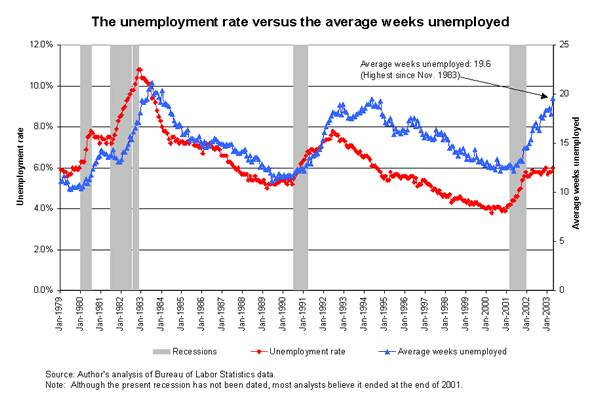Snapshot for May 28, 2003.
The long goodbye—workers staying unemployed longer
Numerous commentators have pointed out that this recession and jobless recovery is considerably milder than in previous cases. Unemployment, which broke 10% in the early 1980s recession, has not gone above 6% in this recession. Yet, as the figure below reveals, the lower unemployment rate in the current downturn is combined with historically lengthy spells of joblessness, leading to an unusually wide gap between the unemployment rate and the average length of time spent unemployed. As explained below, the 6% unemployment rate understates the extent of labor market weakness in the current economy.

The average length of unemployment is a good measure of the availability of work, falling in times of strong job growth as the unemployed are able to quickly find work, and rising as the economy weakens and jobs become more scarce. Despite the fact that the unemployment rate has risen little over the past year, the average length of unemployment spells has continued to climb, hitting 19.6 weeks last month-the highest level since 1983. This creates a gap between the unemployment rate and the trend in unemployment spell lengths.
There are two primary reasons for the current gap between unemployment and average unemployment spell length. First, despite the recovery, the labor market has been shedding jobs. Private sector payrolls were down 80,000 last month, for a total of 538,000 jobs lost so far this year, and 2.7 million since the recession began in March 2001. Thus, there are ever-fewer employment opportunities available to job seekers. Second, this lack of jobs has caused millions to leave the labor market by simply giving up on regularly looking for work; it is important to note that these persons who have discontinued their job searches are not counted in the unemployment rate. Including such persons in the measure of joblessness would reduce the gap between the unemployment rate and the average unemployment spell length, implying that the 6% unemployment rate, while low by historical standards, masks the full extent of labor market weakness.
Related publications:
Snapshot for April 23, 2003: Underemployment hits 10% as gap with unemployment expands.
EPI Issue Brief #194 (May 2003): The broad reach of long-term unemployment.
This week’s Snapshot by EPI economist Jared Bernstein with research assistance by Brendan Hill.
Check out the archive for past Economic Snapshots.
